This article gives a detailed introduction to the important role of the pull-up resistor in the MCU. I believe that after reading this article, everyone has a certain understanding of why the pull-up resistor should be added to the MCU. I hope everyone can gain something after reading this article. In the single-chip system, the pull-up resistor has gradually become the most stable and most reliable main component. Most people know the important role of pull-up resistors in microcontroller systems, but don't know why it's so important. This article will explain the importance of pull-up resistors. Why do most of the pins and microcontrollers have pull-up resistors? Experts say that it is inevitable that the pin and the MCU are connected to the pull-up resistor. Compared with the pull-up resistor and the pull-down resistor, the pull-up resistor is better. As we all know, the pull-up resistor is to clamp the indeterminate signal through a resistor to the high level, the input current, and the resistor simultaneously act as a current limiter. The strength of the resistance is only the structure of the pull-up resistor. In fact, there is no strict distinction. For non-collector open-output or open-drain output circuits, pull-up is limited in the ability to boost current and voltage in this type of circuit. Its main function is the open collector output type circuit. Output current channel.

In general, there are two reasons for the pull-up and pull-down design of the pin to directly determine the access of the pull-up resistor. First, in normal operation or single fault state, the pins should not be in an indeterminate state, such as the suspension of the pins caused by the connectors falling off. Secondly, from the perspective of the power consumption of the body, the resistance of the pin port can not consume too much current for a long time in the pin waiting state, which is especially important for the service life and safety of the battery-powered device. From the perspective of immunity, the signal port should also prefer the pull-up resistor. When the pull-up resistor is connected, the source input is always in a high-impedance state in the standby state. At this time, if there is no access to the pull-up resistor, the input wire will exhibit an antenna effect. Once the pin is subjected to radiation interference, the pin input state is very easily changed by the induction. In addition, after the pin is connected to the pull-up resistor, the most important point is to provide a drain channel to prevent high-level interference. If strong radiation interference occurs at this time and the intensity even exceeds the level of Vcc, the high-level interference on the wire will be discharged to Vcc through the discharge channel provided by the pull-up resistor. Therefore, no matter what kind of radiation interference, there will be no false triggering, which provides great guarantee for the safety performance of the system.
Recently, some engineers are confused about the external connection of pull-up resistors when dealing with the working problems of the IIC microcontroller interface. Since the pull-up resistor has been set inside the microcontroller, the industry has been controversial about whether the external pull-up is still required. Since some MCU models have a pull-up resistor internally, some pull-up capability is sufficient. It is possible to add a pull-up resistor without adding a pull-up resistor. In this case, it depends mainly on whether the microcontroller used by the engineer has a standard IIC standard interface. If the microcontroller uses a standard IIC interface, the pin will enter the open-drain mode when enabled, eliminating the need for externally connected pull-up resistors. However, if the pin analog IIC protocol of the MCU is used, it is necessary to judge whether the MCU pin supports the open-drain mode or the pull-up mode. In this case, an external pull-up resistor is generally required.
In addition, the pull-up resistor can be connected to the IIC interface to protect it. Since the I2C interface is mainly responsible for the high and low level detection during operation, once the power supply is directly connected to the power supply without the protection of the pull-up resistor, the entire system is very dangerous when the device is pulled low. According to the I2C bus specification, both lines must be high when the bus is idle. According to the requirements of the IIC bus specification, both lines must be high when the bus is idle. However, since the IIC interface adopts the OpenDrain mechanism, it can only output a low level and cannot actively output a high level, so the signal line can only be pulled to a high level by an external pull-up resistor RP. Therefore, the pull-up resistor on the I2C bus must be connected.
This brush is small turbo brush. It's a specil Vacuum Cleaner brush. It's a good helper of acarus killing,so it will give you a safe and clean environment. It's mainly made up of multi-function soft brush,colorful pneumatic brush body,transparency cover and rotation type brushing fur. It's also a vacuum cleaner brush with six functions. First,automatic compensation function into the wind that will let rolling brush always run. Second,unique and simple structure, tear open outfit clean is very convenient. Third,high efficiency of dust collection and super silent. Fourth,deep cleaning and professional in addition to mites. Fifth,modelling is novel and beautiful. The last one is its new function that is rotating transformation multifunctional suction brush. This is really a very useful and beautiful vacuum cleaner brush,hope you will like it. Now let's see picture blow.

Small Turbo Brush, Turbo Brush, Vacuum Turbo Brush
Ningbo ChinaClean Household Appliances Manufacture Co., Ltd. , https://www.chinaclean-elec.com